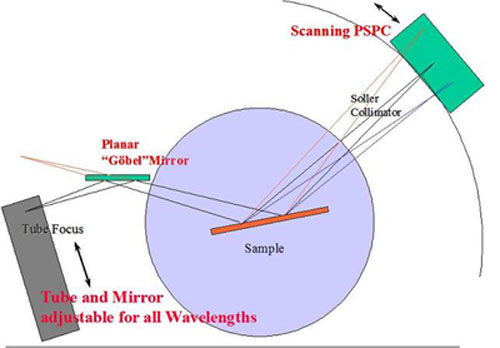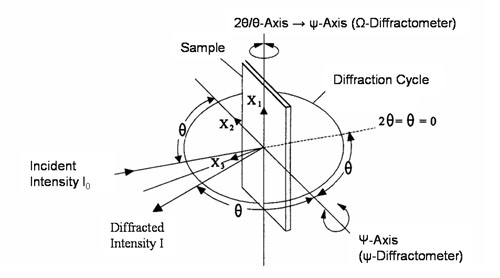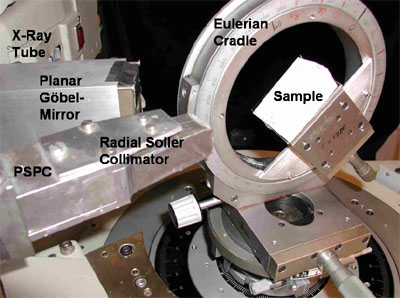
BRAGG-BRENTANO DIFFRACTOMETER

Schematic view of our Bragg-Brentano system.
General Description
The Bragg-Brentano focussing principle is the most widespread in x-ray powder diffraction and is described in all textbooks, e.g. Klug / Alexander: X-Ray Diffraction Procedures; W. Parrish: Int. Tables for Crystallography (Vol. C, pp. 42 - 79). The standard instruments use a line focus x-ray tube (mostly Cu-radiation), collimators and Soller-slits to define the beam divergence. On the diffracted beam side a Kβ-filter (or graphite monochromator) in combination with a scintillation counter defined the energy window of the detected radiation. A receiving slit together with the step width of the diffractometer scans define the resolution of the patterns. The diffractometer uses a symmetrical beam and is operated in θ/2θ mode for the sample and detector rotation. Graded multilayer monochromators (Göbel-Mirrors) show high reflectivity also for “soft” radiation and can be tailored with elliptic, parabolic, hyperbolic or flat optical surface to achieve a focussing, parallel or divergent primary beam. An outstanding property of the flat Göbel-Mirrors is that they can be adjusted to any wavelength with minor changes of the primary beam path. This enables a quick change of wavelengths to optimize the penetration depth for a high signal and to avoid the excitation of fluorescence radiation for a low background or to carry out depth sensitive measurements. Together with the scaning position sensitive proportional counter (PSPC) our Bragg-Brentano Diffractometer becomes extremely powerful with respect to data collection speed and quality. With a few minor adjustments it can be switched to Cr-, Fe-, Co- and Cu radiation.

Bragg-Brentano diffractometer.
In addition to the qualitative and quantitative phase analysis also stress analysis by means of the well known sin²ψ and / or sin²Ω technique is possible. In stress analysis the selectable wavelength also allows to reach highest resolution at high diffraction angles so that even very small strains (e.g. in ceramics or ceramic components in composites) can be observed due to the high angular dispersion.

ψ- or Ω-Scans for Stress Analysis [DGM].

Configuration for stress measurements (ψ-mode).
Characteristics
| • | Focussing principle after Bragg-Brentano |
| • | Monochromatic beam |
| • | Selectable wavelength from Cr-, Fe-, Co-, Cu-tubes |
| • | Selectable Kα1,2- or Kβ-radiation |
| • | Scanning PSPC |
| • | Closed Eulerian cradle |
| • | Samples: powders, polycrystalline parts |
| • | Sample size: on request; standard: up to 100 mm Ø, up to 20 mm thick |
Applications
The applications reach from steel and metallurgy, surface problems, coatings to minerals, layered structures, catalysts and pigments. Especially measurements on compounds containing iron group or rare earth elements can so be optimized.
| Example 1: | Low background measurement in Fe-containing mineral pigments. |
| Example 2: | Sensitive detection of minor phases in steels (retained austenite, carbides, nitrides and oxides). |
| Example 3: | Characterisation and depth profiling of surface layers for steel hardening and protection. |
| Example 4: | Stress measurement on γ-iron (Austenitic steel) using the (311)-reflection at 147° 2θ with Cr-Kβ - radiation in analogy to the combination of Cr-Kα-radiation with the (211)-reflection at 156° 2θ of Ferritic steel. |
| Example 5: | Stress measurements and the sin²ψ-evaluation method in thin Mo-films on glass substrates. |
Example 1: Low background measurement in Fe-containing mineral pigments (Red/Brown Pigment Umbra).
Example 2: Sensitive detection of minor phases in steels. 0.1 % retained Austenite in hardened steel (1 % Cementite).
Example 3: Characterisation and depth profiling of surface layers for hardening and protection of motor parts - plasma Oxid/Nitrid layers on steel.
Example 4: Stress measurement on γ-iron (Austenitic steel) using the (311)-reflection at 147° 2θ with Cr-Kβ - radiation in analogy to the combination of Cr-Kα-radiation with the (211)-reflection at 156° 2θ of Ferritic steel.
Example 5: Stress measurements and the sin²ψ-evaluation method in thin Mo-films on glass substrates.